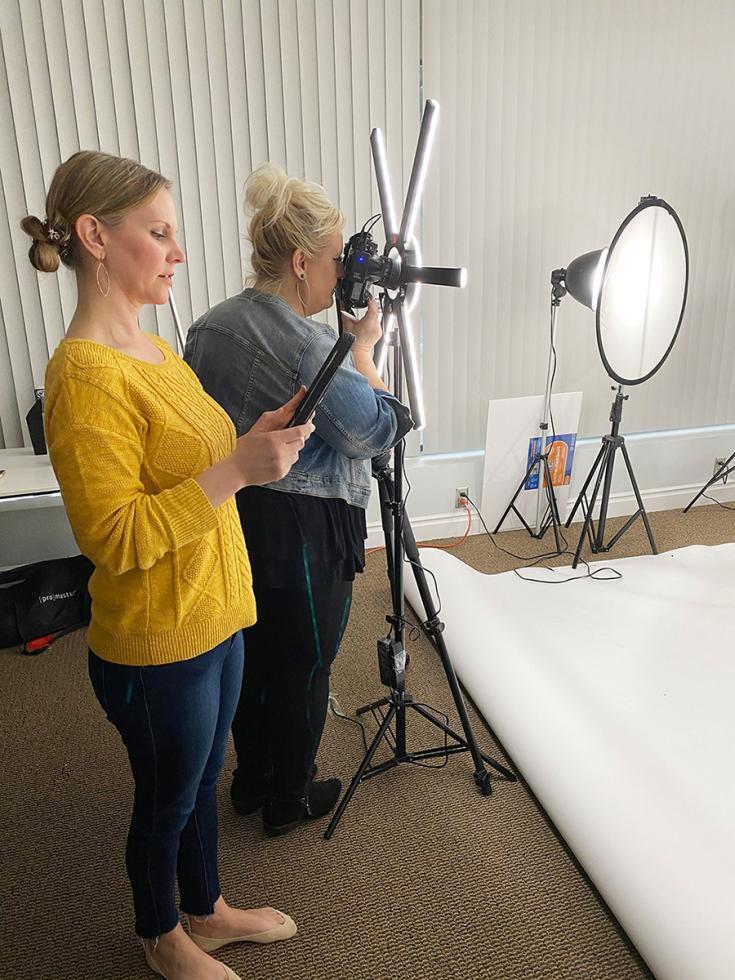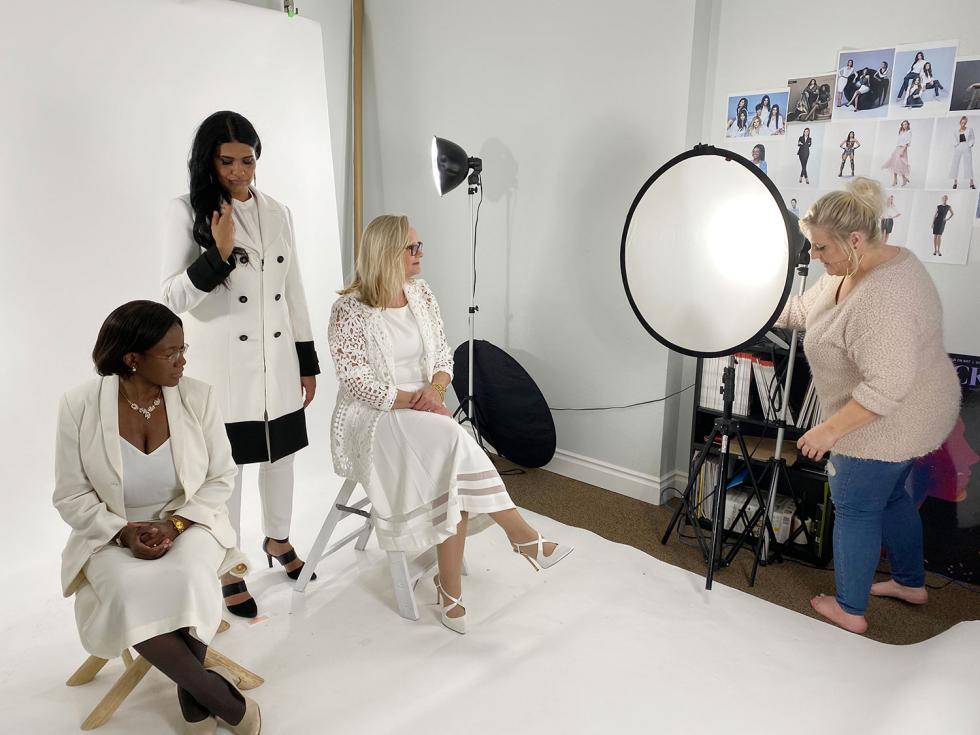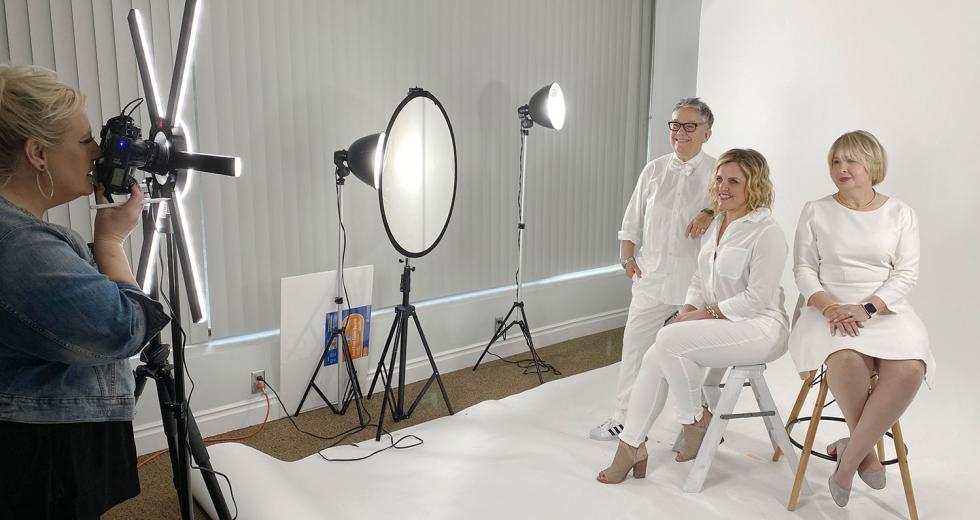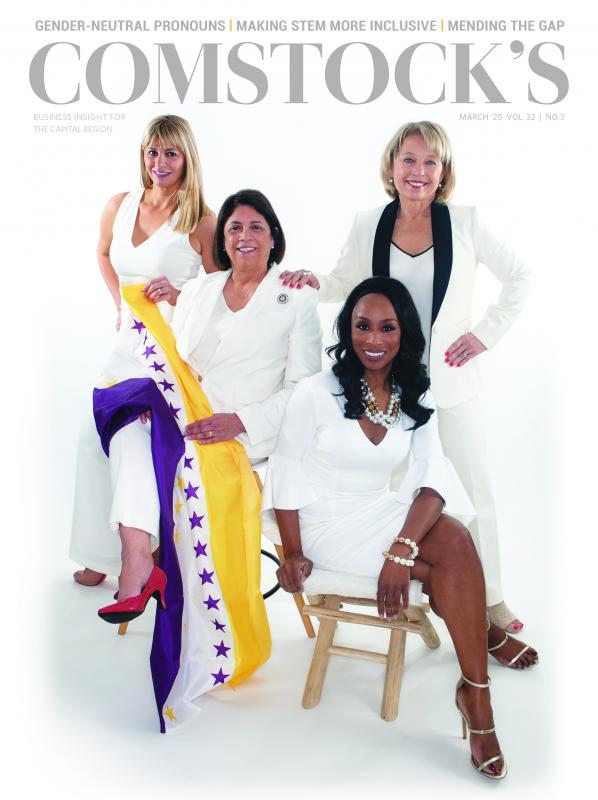I cast my first ballot in a presidential election during my second year of college. I went to the precinct after school and soccer practice and before my shift at a retail job. What now seems an innocuous description of a day in the life of one young woman would have been a bold statement not that long ago — before universities opened to female students, before competitive sports teams existed for women, before women got paid for their labor, before the U.S. Constitution guaranteed all Americans the right to vote.
Comstock’s Art Director Carly Cornejo, left, and photographer
Rachel Valley check the lighting for our Women in Leadership
photo shoots. (Photo by Marissa Lewis)

For the longest time, women’s existence in the United States was one of exclusion — from politics and the places men gathered to do this work in the early days of the Republic, like taverns and courthouses. Women were mostly prevented from being in the public sphere. It was the great paradox of the Age of Enlightenment, which precipitated the American Revolution, that despite the growing acceptance of self-governance, democracy, freedom and autonomous will, half of the population — women — could be regarded as lacking the capacity to reason because of their biological sex and, thus, couldn’t be granted the same rights as men.
In 1848, the Seneca Falls Convention officially launched the women’s suffrage movement. While battles over philosophies and tactics led to divisions between the moderates and radicals, in 1890 the groups reunited, making the argument that women are both equal to men and different and should be involved in politics. Throughout the movement, some women were once again excluded — specifically black, uneducated and poor women. That didn’t stop many African Americans from mobilitizing at local levels, through a network of church and social groups, according to a recent story in The Baltimore Sun that highlighted the history of black suffragists.
From left: Olivia Kasirye, Preet Kuar and Alice Sauro get ready
to be photographed by Rachel Valley. (Photo by Marissa Lewis)

It took seven decades for enough states to ratify the 19th Amendment to the U.S. Constitution, which prohibits sex discrimination in the right to vote. Congress passed the amendment June 4, 1919, and it was ratified Aug. 18, 1920, enacting “the single largest extension of democratic voting rights in American history,” according to the National Women’s History Museum. The amendment, however, didn’t stop states from discriminating on the basis of race, leaving millions of African Americans in the South unable to vote because of barriers such as poll taxes and literacy tests. Racist laws prevented many Native Americans and Asian immigrants from obtaining citizenship, meaning they too were disenfranchised.
Despite the flaws of the suffrage movement and its aftermath, the 19th Amendment was critical in ushering women more fully into the political process and the public sphere. The United States was finally on its way to becoming more inclusive and representative of all the people who call this country home.
See this letter in print: click here to find where to buy Comstock’s magazine
In celebration of the centennial of the 19th Amendment, Comstock’s is honoring 19 regional leaders for our annual tribute to women in leadership. We selected these women from more than 80 nominees, and they represent a variety of industries, such as banking, law, education, arts, construction, energy, health care and technology. Several of them took the helm during the Great Recession, leading their organizations out of that turbulent time. One woman oversaw the recovery phase of the Oroville Dam crisis in 2018, another revived a struggling arts organization and another is helping develop more affordable housing in Sacramento’s central core, and many expressed a commitment to mentoring the next generation of women leaders. In honor of the suffrage movement, we photographed these women wearing white, accompanied with the other colors of the suffrage flag, gold and purple.
This issue also includes coverage about how despite the many advancements for women over the past century, challenges remain. We report on how women continue to carry the load of caregiving both to their children and aging parents. We write about efforts in California to close the gender wage gap. And something we’re very excited about: The issue is created almost entirely by women writers, photographers, illustrators, editors and designers.
From left: Melissa Jones, Cecilia Aguiar-Curry, Erica Manuel and
Catherine Reheis-Boyd pose with the flag of the women’s suffrage
movement. (Photo by Marissa Lewis)

Yet, as we honor the anniversary of the 19th Amendment on the eve of a presidential election, we need to take a somber moment to reflect on how the voting rights of millions are threatened as states impose more restrictive registration and voting laws, like the 36 states with identification requirements at the poll and the seven states with strict photo ID laws. The U.S. Government Accountability Office reports that voter ID laws reduce voter turnout. Two of the most populous states in the country, Texas and New York, require voters to register at least 30 days and 25 days before the election, respectively; in the 2016 election, both states had among the worst voter turnouts in the country. Minnesota allows for Election Day registration, and it had the best turnout in 2016. The Guardian reported that tens of thousands of Iowans were shut out of the 2020 caucus due to physical or legal obstacles, including people with disabilities and people with felony convictions who had completed their sentences but are banned from voting for life.
Purging voter rolls, if not done properly, is another significant threat. A 2018 report from the Brennan Center for Justice at New York University School of Law found that “between 2014 and 2016, states removed almost 16 million voters from the rolls. … Almost 4 million more names were purged from the rolls between 2014 and 2016 than between 2006 and 2008. This growth in the number of removed voters represented an increase of 33 percent — far outstripping growth in both total registered voters (18 percent) and total population (6 percent).”
The time of exclusion must come to an end. All Americans — people of color, those with disabilities, the elderly, students, working parents who can’t leave a child at home to vote in person, former felons who have served their time — should have their voices heard in the political process. We need to expand voter participation, not limit it, if we want our democracy to truly reflect the will of the people.
Shortly after I voted in my first presidential election, I took my first women’s studies class in college and read an essay by Audre Lorde, underlining the first line: “I have come to believe over and over again,” Lorde wrote, “that what is most important to me must be spoken, made verbal and shared, even at the risk of having it bruised or misunderstood. That the speaking profits me, beyond any other effect.” This line has guided me since. It reminds me that my voice — as does yours — matters. It’s why throughout the course of my journalism career I have tried to elevate the voices and stories of people who have been marginalized. It’s also why I vote.
Sena Christian
Managing Editor
–
Get all the profiles in our biggest-ever Women in Leadership issue delivered to your inbox: Subscribe to the Comstock’s newsletter today!





